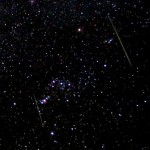A reminder that tonight is the peak of the Geminid meteor shower. Meteors will begin to appear around 8pm when the constellation Gemini and the radiant rises. The peak occurs at 8am on the 14th, favoring the early morning hours. As the Geminid meteors have a broad peak activity can be expected to be good all night long.
Tag: Geminid
Geminid Meteor Shower
The annual Geminid meteor shower is one of the most reliable annual meteor showers. The shower is noted for a steady stream of bright meteors with rates of well over 100 per hour.

The shower peak is predicted for December 14th, at around 18:00UT (14Dec 08:00HST). For viewers in the central Pacific this favors the evening of Dec 13th into the morning of Dec 14th, starting around 8pm as Gemini rises in the east. The peak is broad, with near peak rates occurring a day either side of the maximum, thus allowing everyone with a dark sky to enjoy this event. Thus the evening of the 14th may also provide a good viewing opportunity.
Even from more southerly sites, this is an excellent stream of often bright, medium-speed meteors, a rewarding event for all observers, whatever method they employ. The peak has shown slight signs of variability in its rates and timing in recent years, with the more reliably-reported maxima during the past two decades (HMO, p. 171) all having occurred within λ⊙ = 261.5° to 262.4°, 2015 December 14, 01h30m–23h UT. Near-peak Geminid rates usually persist for almost a day though, so much of the world has the chance to enjoy something of the shower’s best, regardless of when the maximum actually happens. Mass-sorting within the stream means fainter telescopic meteors should be most abundant almost a day ahead of the visual maximum, with telescopic results indicating such meteors radiate from an elongated region, perhaps with three sub-centres. Further results on this topic would be useful. The 2015 peak arrives just three days after new Moon, so observing conditions are ideal. – IMO 2015 Meteor Calendar
As noted by the IMO calendar entry above, new Moon will be on the 11th, placing the peak just a few days after new, a thin crescent in the evening sky that will set early. This leaves a perfect dark sky to enjoy the meteor shower. In the islands Gemini will rise around 8pm, bringing the constellation Gemini and the shower radiant over the horizon and marking the start of the show.
Watching meteors requires no more equipment than your eyes and a dark sky, and can be enjoyable for just about anyone.
Geminids and a Comet
Stayed up late tonight to check on a few things in the sky. Firstly the Geminid meteor shower, which is peaking nicely. At least 100ZHR and bright enough to be nicely visible, even against the light of a bright gibbous moon.
The second item I wanted to see was comet C/2014 Q2 Lovejoy, now climbing higher in the sky as it swings northwards. It is currently somewhat low in Puppis, but getting higher each night as it moves nearly due north against the constellations. Currently it is an easy binocular object at around 7th magnitude. A quick sweep with my 9×50’s picked it up without effort halfway between Adhara and Canopus.
It is forecast to reach around 5th magnitude over the next month. Peak magnitude should occur near the new year while the comet is in Lepus. We placed and quite bright, I will be arranging to get a few photos of this comet through the new year!
Geminid Meteor Shower
The annual Geminid meteor shower has become one of the most reliable annual meteor showers. First observed over 150 years ago this is a interesting meteor shower. The parent body for the Geminids is not a comet, but rather the asteroid 3200 Phaethon. It is somewhat of a mystery how this mostly rocky body gives rise to the debris stream needed to generate a meteor shower.

While the 2013 Geminids are expected to just as numerous as usual, viewing will be hampered by a bright Moon in the sky. Full Moon occurs on the 16th, placing peak just a few days before full. This puts a big, bright Moon in the sky for much of the night. Certainly the brighter fireballs will be easily visible, but the dim meteors will be lost to the moonlight. A dedicated observer might make use of the small window of time between moonset at 5:24am and sunrise about 06:50am on the morning of the 14th.
Watching meteors requires no more equipment than your eyes and a dark sky, and can be enjoyable for just about anyone.
Quadrantid Meteor Shower
The first meteor shower of 2013 is the annual Quadrantid meteor shower. The Quadrantids are a reliable shower, producing 60-120 ZHR, one to two meteors per minute. The Quadrantids are named for the obsolete constellation Quadrans Muralis, now part of the constellation Boötes.
Unlike other showers where activity can occur for days or even weeks, the Quadrantids have a sharp peak, activity falls off rapidly on the preceding and following nights, or even a few hours away from the peak. Thus it is important to observe the Quadrantids quite near the peak prediction. For 2013 the peak is predicted for January 3rd around 13:33UT, or 03:33HST on this side of the globe, excellent timing. This is the good news for observers here in Hawai’i. The bad news is that the peak will be sullied by the light of a bright last quarter Moon.
Watching meteors requires no more equipment than your eyes and a dark sky, and can be enjoyable for just about anyone. While the viewing conditions for this year’s Quadrantids are possibly spoiled by moonlight, it may still be worth a peek. Set the alarm early?
